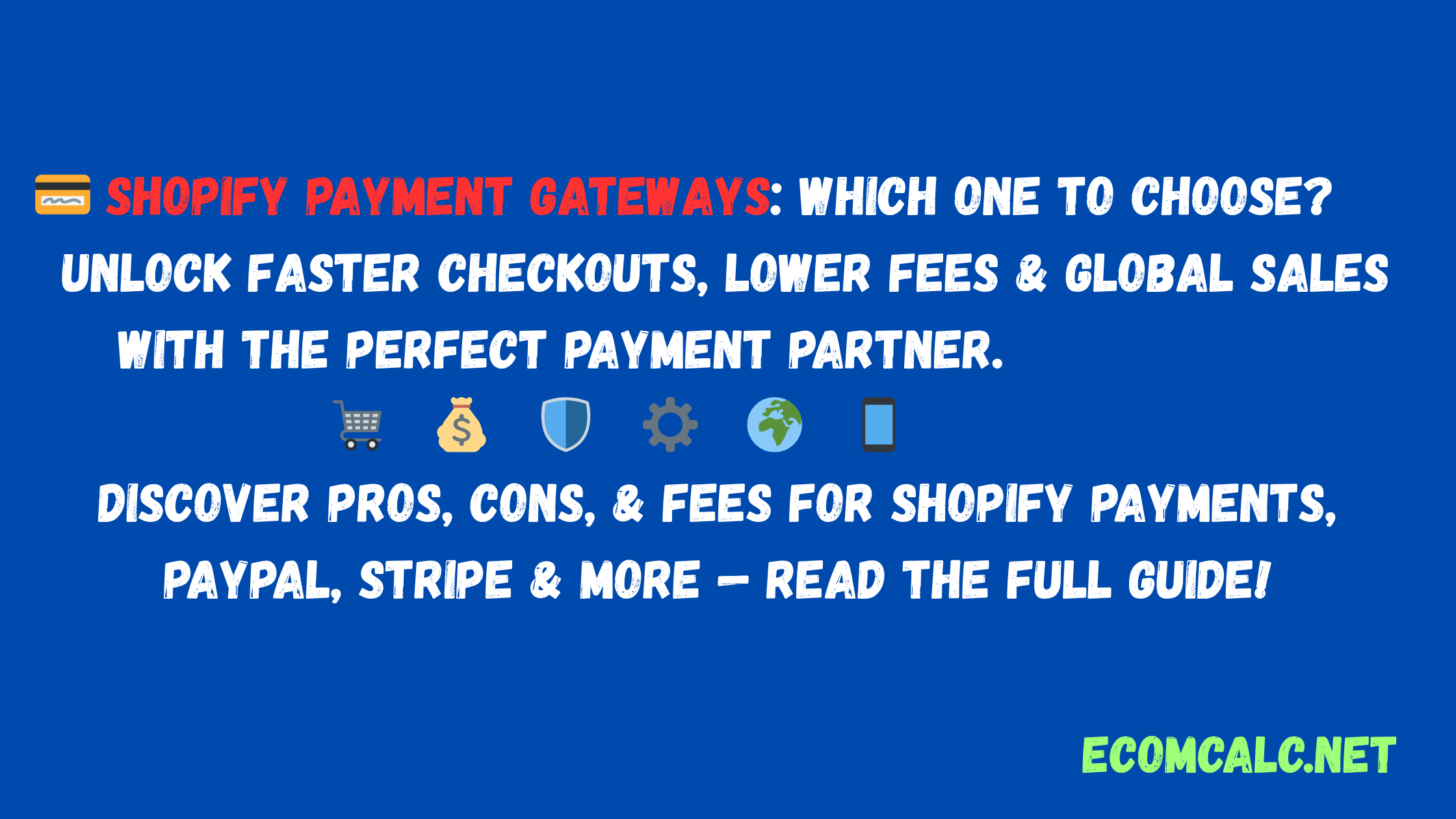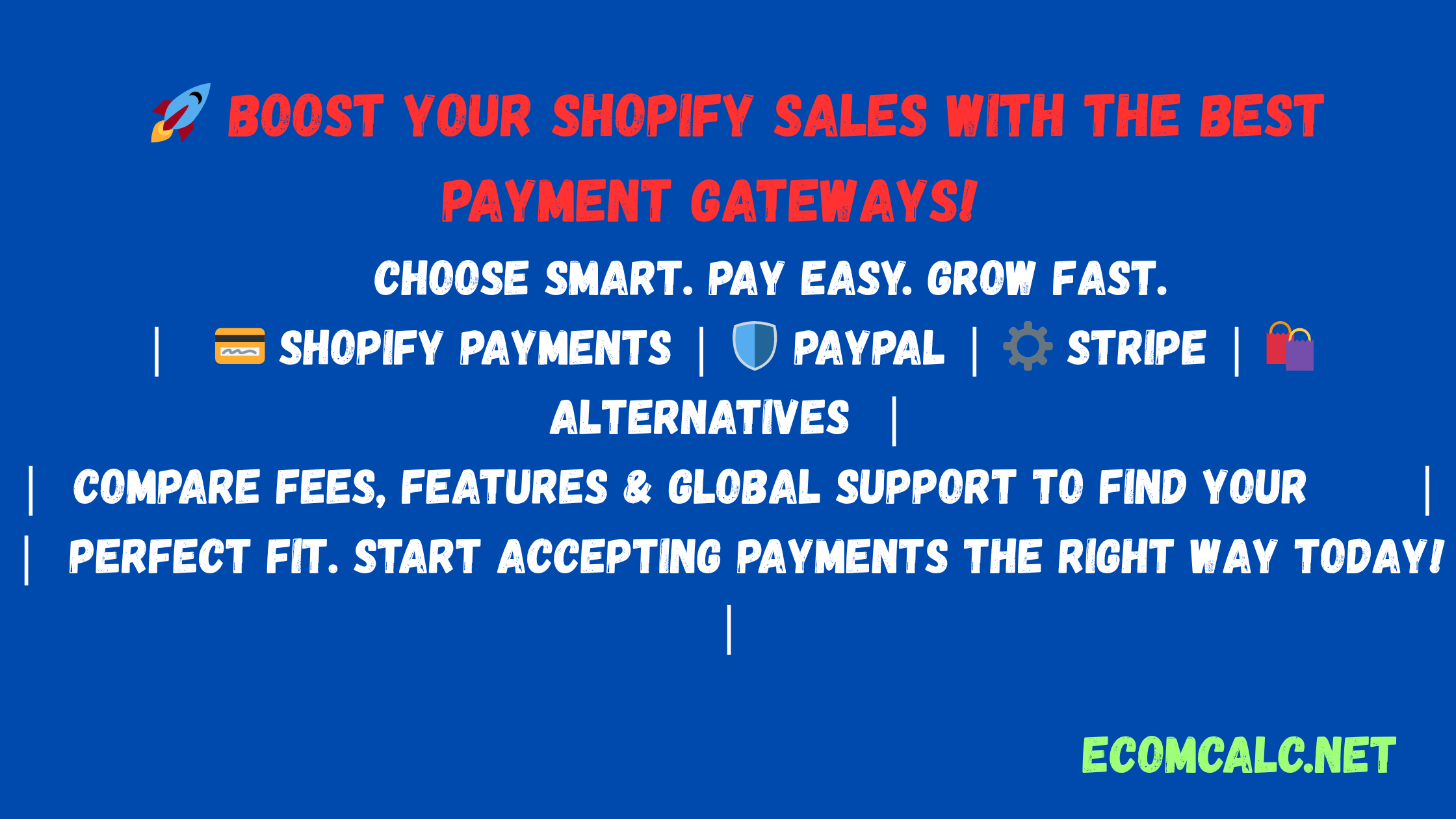Shopify Payment Gateways: Which One to Choose?
Published on March 5, 2023 | 8 min read
💳 Why Payment Gateways Matter in E-commerce
A reliable payment gateway plays a critical role in shaping the success of an e-commerce store. It directly influences how quickly and smoothly customers can complete purchases, impacting their overall shopping experience and your conversion rates. The efficiency of the payment process often determines whether a buyer finalizes a sale or abandons their cart.
Beyond convenience, the choice of payment gateway affects key business metrics such as transaction costs, international reach, and the level of security offered against fraud. A robust system helps build consumer trust, ensures data protection, and supports seamless global transactions—making it an essential pillar of a profitable and scalable e-commerce operation.

🥇 1. Shopify Payments: The Seamless Default
Shopify Payments is the built-in payment gateway offered by Shopify, designed to deliver a streamlined experience for both sellers and buyers. With transaction fees ranging from 2.4% to 2.9% plus a $0.30 flat fee, this option also eliminates the extra transaction charges that usually come with third-party providers—making it a cost-effective solution for many merchants. Since it’s directly integrated with the Shopify platform, there’s no need for external setups or complex configurations, allowing for a smoother checkout experience.
The main benefit of using Shopify Payments is its seamless compatibility with the Shopify ecosystem. It accepts all major credit cards and supports digital wallets like Apple Pay, Google Pay, and Shop Pay, ensuring flexibility for customers. Additionally, it often ends up being the most affordable option for store owners. However, there are some limitations to consider. Shopify Payments is only available in certain countries, and businesses that deal in restricted product categories may not be eligible. These restrictions can be a drawback for international sellers or those with niche products.
Pros:
- Integrated with Shopify
- Lowest overall cost
- Supports major cards, Apple Pay, Google Pay, and Shop Pay
Cons:
- Only available in select countries
- Restrictions on certain products
🛡️ 2. PayPal: The Household Name with a Few Catches
PayPal stands out as one of the most recognized and widely accepted online payment platforms, making it a smart choice for merchants whose buyers regularly opt for PayPal at checkout. Known for its reliability and global reach, PayPal doesn't charge a monthly subscription fee and allows sellers to accept payments through various channels like PayPal Credit and Venmo, expanding customer flexibility. This makes it particularly appealing for small to mid-sized businesses aiming to offer a seamless and familiar checkout experience to their users.
However, merchants should be aware of some potential downsides. PayPal's standard transaction fee is 2.9% plus $0.30 per sale, and an additional 2% fee applies on Shopify transactions if you’re not using Shopify Payments. Additionally, higher-than-average chargeback rates can be a concern, potentially affecting your revenue. Another challenge some sellers face is the possibility of unexpected account holds or freezes, especially during disputes or unusual transaction spikes. While it remains a reliable and widely used platform, it’s important for sellers to weigh the convenience of PayPal against these operational risks.
Pros:
- Trusted globally
- No monthly fees
- Supports PayPal Credit, Venmo
Cons:
- Higher chargeback rates
- Account freezing risk

⚙️ 3. Stripe: Flexible and Developer-Friendly
Stripe is a highly adaptable payment processing platform designed with developers and international businesses in mind. Known for its robust API integration, Stripe allows for full customization, making it ideal for companies seeking a tailored checkout experience. It supports over 135 currencies, enabling smooth transactions across borders. This makes it especially valuable for global e-commerce platforms that cater to diverse customer bases. Stripe also shines in handling recurring billing, making it a top choice for subscription-based services.
Despite its flexibility, Stripe may require a more complex setup compared to plug-and-play options, which could be a hurdle for non-technical users. Additionally, when used with Shopify, Stripe incurs a standard processing fee of 2.9% plus 30 cents per transaction, with an added 2% fee if Shopify Payments isn’t utilized. International transactions may also attract extra fees. However, for businesses willing to invest in a custom payment solution, Stripe offers unmatched scalability and control. Whether you're launching a SaaS platform or expanding your e-commerce footprint globally, Stripe offers the tools and flexibility needed to support sophisticated payment needs.
Pros:
- Supports 135+ currencies
- Full API access
- Great for subscriptions
Cons:
- Custom setup needed
- International transaction fees
💼 4. Authorize.Net: The Enterprise Workhorse
Authorize.Net stands out as a robust payment solution designed to meet the needs of high-volume merchants and B2B enterprises, especially those already equipped with a merchant account. With its enterprise-grade infrastructure, it handles large transaction volumes efficiently and offers versatile payment options including credit cards and eChecks. This makes it an excellent fit for established businesses looking for a reliable, secure, and scalable platform to process payments.
The service comes with a $25 monthly fee, in addition to 2.9% plus $0.30 per transaction, alongside Shopify’s own charges. While the cost may be higher compared to simpler platforms, Authorize.Net compensates by offering advanced fraud prevention features, high-level customization, and strong support for recurring billing. However, the initial setup can be somewhat complex, which may be a hurdle for smaller businesses or beginners. Its monthly fees also add up over time, making it less suitable for startups or low-volume merchants. Overall, it’s a powerful choice for enterprises that prioritize security, flexibility, and comprehensive payment processing capabilities.
Pros:
- Advanced fraud tools
- Supports eChecks
- Enterprise-ready
Cons:
- Monthly fees
- Complex setup
🛍️ 5. Alternative Payment Methods: The Conversion Boosters
To reduce cart abandonment and enhance the mobile shopping experience, offering alternative payment methods has become a game-changer for eCommerce businesses. These payment options, including Apple Pay, Google Pay, Amazon Pay, Meta Pay, Shop Pay, and even cryptocurrencies, allow users to make purchases quickly and securely without the need to input lengthy card details. Especially on mobile devices, these one-tap or biometric-enabled payments streamline the checkout process, encouraging faster transactions and fewer drop-offs. They cater to modern shoppers who value speed, convenience, and flexibility.
Integrating alternative payment systems significantly enhances user experience by reducing friction during checkout. For mobile-first customers, the simplicity of these methods can lead to higher conversions and improved customer satisfaction. However, these solutions may not be universally available across all regions or devices, which could limit their accessibility. Additionally, each payment method might require its own setup process, adding extra steps for store owners during implementation. Despite these challenges, offering a variety of payment options signals trustworthiness and modernity, making it easier for diverse audiences to complete their purchases with confidence.
Popular Options:
- Apple Pay
- Google Pay
- Amazon Pay
- Meta Pay
- Shop Pay
- Cryptocurrency
Pros:
- One-tap payments
- Improves mobile experience
Cons:
- Limited availability
- Separate setups may be required
📊 Shopify Transaction Fees Demystified
Shopify charges extra fees for third-party gateways unless you use Shopify Payments:
| Shopify Plan | Shopify Payments | Third-Party Gateway |
|---|---|---|
| Basic | 2.9% + $0.30 | +2% extra |
| Shopify | 2.6% + $0.30 | +1% extra |
| Advanced | 2.4% + $0.30 | +0.5% extra |
🌍 International Payments: What You Need to Know
- Multi-currency support: Stripe and Shopify Payments
- Currency conversion fees: 1–2% with PayPal/Stripe
- Regional compliance: Check PSD2, VAT, GST rules
🧠 Choosing the Right Gateway: A Decision Matrix
| Gateway | Best For | Fees | Global Support | Customization |
|---|---|---|---|---|
| Shopify Payments | All-around, lowest cost | Low | Moderate | Limited |
| PayPal | Customer trust | Medium | High | Low |
| Stripe | Global reach, developers | Medium-High | Very High | High |
| Authorize.Net | Enterprise/B2B | High | High | Medium |
| Alternative Methods | Mobile/UX | Varies | Medium | Low |

✅ Final Recommendations
- Small stores: Shopify Payments + PayPal
- Global stores: Stripe or Shopify Payments with multi-currency
- Subscriptions: Stripe
- Enterprise: Authorize.Net
🔍 Pro Tips to Optimize Payment Gateway Performance
- Test gateways and analyze customer preferences
- Streamline checkout process
- Offer multiple payment methods
- Review fees regularly
- Monitor conversion analytics
🚀 Ready to Choose Your Shopify Payment Gateway?
The right gateway supports your business goals and customer preferences. Use Shopify Payments where possible, and complement it with PayPal and alternative methods to maximize conversions.
🧮 Use the Shopify Calculator
Estimate costs and profits using a Shopify calculator to factor in gateway fees.